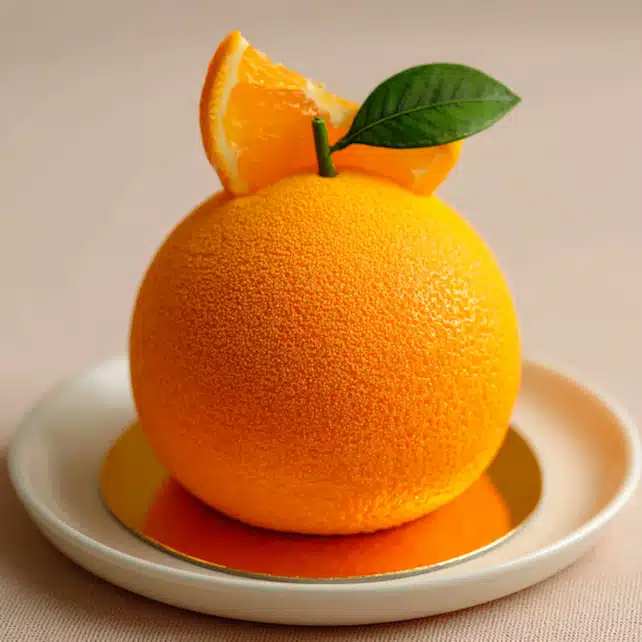Orange shaped pastry is the dessert that has taken over TikTok, Instagram, and top-tier patisseries — and it’s not hard to see why. With a peel so realistic you’ll want to check if it’s edible and a creamy center bursting with citrus flavor, this creation looks like fruit but tastes like a dream.
Unlike ordinary desserts, the orange shaped pastry blends high-level culinary skill with viral-ready visuals. Whether you’re a home baker looking to impress or just someone who loves unique food trends, this eye-catching treat is worth the effort. Inspired by top chefs like Cédric Grolet and adapted by DIY creators, this dessert trend continues to grow because it’s both artistic and absolutely delicious.
In this guide, you’ll discover everything from how to make your own orange shaped pastry at home, why it’s gone viral, how it compares to other fruit-inspired creations, and tips for finding or customizing it to your taste and diet. Let’s start with how to create this edible masterpiece from scratch.
Table of Contents
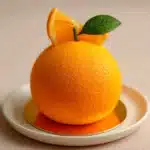
Orange Shaped Pastry Recipe: The Most Stunning Dessert of 2025
- Total Time: 6 hours
- Yield: 6 servings 1x
- Diet: Vegetarian
Description
A visually striking orange-shaped pastry, featuring a citrus marmalade center and silky white chocolate orange ganache, finished with a velvet cocoa butter spray to resemble a real piece of fruit.
Ingredients
3 ripe oranges
1 teaspoon lemon juice
2 tablespoons lime juice
1 cup sugar
1 tablespoon fruit pectin
1 tablespoon orange liqueur (optional)
1 cup white chocolate, chopped
1 cup heavy cream
1 tablespoon lemon verbena
1 teaspoon powdered gelatin
2 tablespoons cold water
1⁄2 cup reserved orange purée
White chocolate and cocoa butter for spray
Silicone orange molds
Instructions
1. Boil whole oranges for 20 seconds. Transfer to ice water, then peel.
2. Blend peeled oranges into purée. Pass through a sieve.
3. Combine purée, lime juice, sugar, and pectin. Boil for 2 minutes. Cool, add cubed orange and liqueur if using.
4. Fill silicone half-sphere molds with marmalade. Freeze until solid.
5. Heat cream with verbena. Infuse, strain over chocolate to melt.
6. Bloom gelatin in water, blend into ganache. Add purée, cream, and mix.
7. Chill overnight. Whip ganache, fill molds halfway, add inserts, then top off and freeze.
8. Carve peel texture. Spray with white chocolate and cocoa butter for velvet finish.
Notes
Optional liqueur deepens the orange flavor but can be skipped.
Use silicone orange molds for best results and realistic shape.
If no lemon verbena is available, try a hint of basil or mint for herbal aroma.
- Prep Time: 45 minutes
- Cook Time: 15 minutes
- Category: Dessert
- Method: Frozen, Molded
- Cuisine: French-Inspired
Nutrition
- Serving Size: 1 pastry
- Calories: 260
- Sugar: 21g
- Sodium: 30mg
- Fat: 18g
- Saturated Fat: 11g
- Unsaturated Fat: 6g
- Trans Fat: 0g
- Carbohydrates: 25g
- Fiber: 1g
- Protein: 3g
- Cholesterol: 35mg
Orange Shaped Pastry Recipe Guide
Step-by-Step Custard-Filled Orange Pastry
Making an orange shaped pastry at home might seem complex, but it’s totally doable with the right tools and a clear process. The idea is to mimic the appearance of a real orange while delighting your palate with layers of mousse, sponge cake, and marmalade hidden inside.
You’ll need:
- Silicone molds shaped like oranges or domes
- Orange custard or mousse
- Citrus marmalade insert
- White chocolate ganache
- Cocoa butter spray or orange glaze
- A sponge cake base
Instructions:
- Boil fresh oranges for 20 seconds and chill them in ice water. Peel and blend into purée.
- Simmer the purée with sugar, lime juice, and pectin to make a marmalade. For extra flavor, you can add a splash of orange liqueur.
- Pour the marmalade into half-sphere molds and freeze to create the center filling.
- Infuse heavy cream with lemon verbena, then pour it over white chocolate to make a ganache.
- Bloom gelatin in cold water, mix it into the warm ganache, and blend in the remaining purée. Chill until set.
- Once firm, whip the ganache until smooth. Fill your molds halfway with the ganache, place the frozen marmalade insert in the center, and cover with more ganache to fill.
- Freeze completely until solid. Then carve in peel-like textures and spray with cocoa butter or glaze.
Once defrosted slightly, the result is a glossy, realistic orange with a delicate mousse interior and tangy citrus burst.
Mold Options and Decorating Tips
The secret to a stunning orange shaped pastry lies in the detail. Silicone molds are essential for getting a clean, spherical shape. Choose molds that include stem impressions or a small dimple to enhance the realistic look.
Decoration tips:
- Spray with orange-tinted cocoa butter to achieve a smooth, velvet-like finish
- Apply orange mirror glaze for a high-shine finish
- Place a mint leaf or a small piece of green chocolate on top to mimic the look of a stem
- Use a modeling tool or toothpick to add small dimples for extra realistic texture
These small details elevate your pastry from cute to jaw-dropping.
Substitutions for Gluten-Free or Vegan Diets
This recipe can be customized for dietary needs with a few smart swaps:
- For a gluten-free option, substitute with almond flour or use a certified gluten-free sponge cake
- For dairy-free: replace heavy cream with coconut cream or oat milk
- For vegan: use agar-agar in place of gelatin and aquafaba for mousse stability
Flavor won’t be sacrificed with these changes, and you’ll still end up with a vibrant dessert that fits your lifestyle.
Orange Shaped Pastry Viral Trend
Why Orange Shaped Pastries Are Filling Your Feed
Scroll through TikTok or Instagram lately and you’ll likely spot a dessert that looks like a real orange, but one slice reveals it’s anything but. The orange shaped pastry has exploded in popularity thanks to its hyper-realistic look and satisfying transformation from fruit to mousse-filled masterpiece.
These videos create an immediate wow factor. It’s that visual punch — the moment a pastry knife slices through the velvety peel to expose the creamy filling inside — that captivates viewers. The vibrant color, glossy finish, and unexpected center make it perfect for social sharing.
Why has this trend gained such momentum? It’s not just about looks. Here’s why people can’t stop posting, liking, and recreating these desserts:
- Visually addictive — Bright, glossy, and textured just like a real fruit
- Unexpected reveal — Cutting into it shows mousse or ganache, not citrus
- Satisfying layers — Textures shift from soft to creamy to crunchy in one bite
- Custom-friendly — Fillings can be tailored to personal taste or dietary needs
It’s a stunning edible creation that’s also perfect for grabbing attention on social media. The fact that it tastes as good as it looks only makes it more share-worthy.
TikTok vs Instagram: How Visuals Fuel This Trend
Each platform has helped the orange shaped pastry dominate the food world in different ways.
On TikTok, short clips capture that dramatic slice moment. A simple visual of a knife cutting through what appears to be a whole orange grabs attention instantly. The surprise reveal keeps viewers watching and sharing. Music and dramatic sound effects amplify the experience.
On Instagram, bakers and food artists take a more polished approach. Carousel posts, behind-the-scenes reels, and up-close photos show the full process — from molding mousse to spraying cocoa butter. Followers admire the technique and precision, saving posts for inspiration and tutorials.
Together, these platforms have transformed this dessert into a global phenomenon. The key isn’t just flavor, it’s storytelling through food visuals.
Celebrity Bakers Behind the Hype
The rise of the orange shaped pastry didn’t happen by accident. It was led by some of the most influential names in pastry.
Cédric Grolet, a French pastry chef known for fruit illusions, is one of the key pioneers. His creations are so lifelike, they’re often mistaken for actual produce. Using traditional French techniques combined with modern styling, Grolet sparked a movement that blends precision baking with visual drama.
Following his lead, countless influencers and professional bakers around the world have jumped on the trend. From YouTube tutorials to recipe breakdowns on Reels, their contributions have made this dessert more accessible than ever.
Pastry chefs and creators now add their own spin with unique fillings, colors, and regional flavors. Whether it’s a tropical mango-orange blend or a Persian-inspired orange blossom mousse, the creative variations keep the trend fresh and engaging.
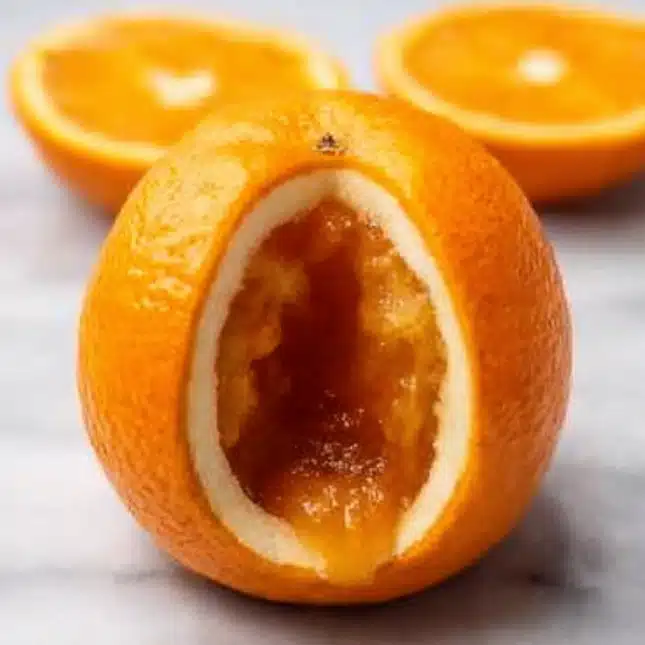
Orange Pastry vs Other Fruit Pastries
Comparing Orange, Mango, and Lemon Versions
The orange shaped pastry may be the most talked-about dessert of the moment, but it belongs to a wider category of fruit-shaped treats that have taken the pastry world by storm. Mangoes, lemons, and even peaches have been turned into lifelike desserts. Each version brings its own flavor profile, aesthetic, and personality to the table.
Here’s how they stack up:
| Fruit Pastry | Look & Texture | Typical Flavors | Best For |
|---|---|---|---|
| Orange | Bright, dimpled shell, velvet or glossy | Citrus mousse, marmalade, white chocolate | Eye-catching centerpieces, classic citrus fans |
| Mango | Smooth, golden-yellow finish | Mango purée mousse, passionfruit, coconut | Tropical themes, summer desserts |
| Lemon | Shiny yellow glaze, puckered shape | Lemon curd, vanilla sponge, zest | Tart lovers, fresh flavor profiles |
The orange shaped pastry stands out for its wide appeal and balance of sweet and tangy flavors. It’s familiar yet elevated, playful yet refined. It also photographs beautifully, which gives it an edge on social media.
Texture Showdown: Crunchy Shell vs Soft Filling
While each fruit-shaped dessert offers unique flavors, texture is where the magic really happens. The best versions create a satisfying contrast between the outer layer and the creamy inside.
An ideal orange shaped pastry offers:
- Outer shell: Thin chocolate coating, velvet cocoa butter spray, or mirror glaze for visual impact
- Middle layer: Silky mousse made from orange zest or purée, sometimes mixed with vanilla or white chocolate
- Insert: Tangy marmalade, fruit gel, or soft sponge cake for bite and flavor surprise
This combination of smooth, creamy, firm, and tangy textures keeps each bite interesting. That’s why pastry lovers keep coming back to this dessert.
Regional Flavor Spins: Asian, French, Middle Eastern
What’s also fascinating is how the orange shaped pastry adapts across cultures. Though rooted in French pastry technique, bakers from around the world have embraced it and added their own flair.
French style: Elegant, with perfectly balanced citrus mousse, smooth texture, and glossy mirror glaze or cocoa spray. Often modeled after haute patisserie by chefs like Cédric Grolet.
Asian influences: Seen in Japan and South Korea, where desserts lean lighter and more delicate. Fillings may include yuzu, mandarin mousse, or subtle floral notes. Presentation is often minimalist but striking.
Middle Eastern twists: Expect bold, warm flavors like orange blossom, cardamom, or pistachio. These versions blend traditional dessert aromas with modern techniques for an exotic spin.
The orange shaped pastry is more than a visual gimmick. It’s a global dessert canvas that invites creativity while staying true to its fruit-inspired roots.
Where to Buy Orange Shaped Pastries
Best Bakeries in Major Cities
If baking isn’t your thing or you simply want to experience the finest version before trying it yourself, the good news is that orange shaped pastries are now available in select patisseries. High-end bakeries in cities around the world are embracing the trend and adding these eye-catching desserts to their menus.
Here are a few places where you’re likely to find one:
New York City
- Known for innovation and presentation, bakeries like Ladurée or Dominique Ansel have featured seasonal fruit-shaped pastries. Watch for seasonal menus and limited-time events.
Los Angeles
- Patisseries such as La Tropézienne or Pitchoun often offer French-style entremets with artistic flair. Their citrus-inspired options rotate throughout the year.
San Francisco
- B. Patisserie and Craftsman and Wolves are known for refined pastry work. Both have unveiled fruit-shaped desserts crafted with remarkable precision and detail.
Miami
- Bachour is among the city’s most photographed bakeries, renowned for its vibrant, tropical-inspired entremets. Their orange shaped pastry is often available during citrus season.
Chicago
- Vanille Patisserie is celebrated for its artistic desserts and features seasonal fruit mousse domes that closely mimic the trendy orange design.
Since these bakeries might not always have orange-shaped pastries available, it’s a good idea to call in advance or check their social media for the latest updates.
How to Search “Orange Shaped Pastry Near Me”
Finding this trendy dessert near you is easier if you use the right tools and keywords. Whether you’re looking to surprise someone with a unique treat or simply want to indulge, use these search tips:
- Type “orange shaped pastry near me” into Google Maps and look for bakeries with high ratings or visual dessert options
- Try alternate keywords like “realistic fruit dessert,” “entremet bakery,” or “French mousse pastry”
- Search hashtags on Instagram like #fruitpastry or #orangeentremet and check geotags for your city
- Explore local Facebook foodie groups or Reddit baking communities — users often post where they’ve found trending treats in your area
This simple research can help you discover hidden gems and specialty bakeries offering custom orders or limited-time desserts.
Price Range and Portion Sizes
An orange shaped pastry may look like a novelty item, but it’s also a labor-intensive luxury dessert. That means the price tag will reflect the artistry and ingredients involved.
Here’s what to expect:
- Price per pastry: $8 to $14 depending on location, filling, and finish
- Size: Roughly the same as a real orange, usually around 3 to 4 inches in diameter
- Weight: Ranges between 100g to 150g per serving
- Servings: Usually meant for one person, but rich enough to split
Despite the size, it’s packed with mousse, curd, or ganache, making it quite indulgent. Most people enjoy it slowly, making the price worthwhile for a special occasion or treat.
For events or gifting, some bakeries offer boxed sets or custom designs, adding stems, leaves, or edible tags to make the pastry even more lifelike.
DIY Orange Dessert for Home Bakers
Easy Hacks for Realistic Orange Peel Finish
Recreating an orange shaped pastry in your kitchen doesn’t require a professional pastry degree. With a few smart tools and techniques, you can achieve that same stunning, citrusy illusion at home. One of the most important steps is crafting the peel — it’s what sells the illusion.
Here are a few simple tips to recreate the realistic texture of orange peel:
- Use a frozen real orange to press texture into soft mousse before freezing
- Lightly carve dimples into the frozen shell with a toothpick or sculpting tool
- Apply orange-colored cocoa butter spray to the surface for a soft, matte velvet finish.
- For a shinier look, use a mirror glaze made with orange food coloring and a touch of gelatin
The final step is crucial. Add a small mint leaf or edible chocolate stem on top. This gives your dessert the finished look of a freshly picked orange.
Even if you don’t have access to a professional spray gun or silicone molds, you can still pull off an impressive result with everyday kitchen tools.
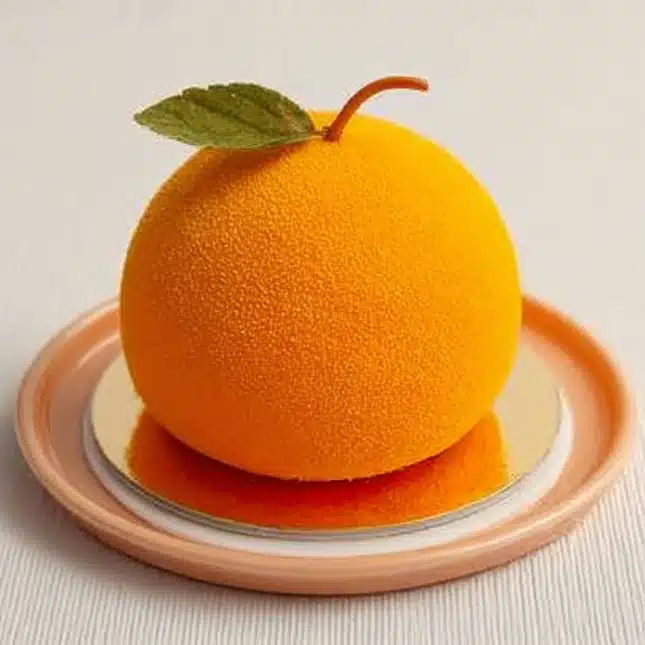
Using Silicone Molds vs Hand Carving
If you’re just starting out with entremet-style pastries, a silicone mold is your best friend. These molds provide structure, save time, and produce a uniform shape every time.
Advantages of silicone molds:
- Easy to fill and demold
- Consistent shape and size
- Better surface for applying cocoa butter spray or glaze
They’re available in various shapes online, and many are designed specifically for citrus patterns. If you can’t get your hands on a mold, you still have options.
To shape without a mold:
- Line a small round bowl with plastic wrap
- Add the mousse, then place your filling or sponge layer in the center
- Freeze until solid, then carve gently using a sharp knife
This method requires more effort but delivers a stunning result with a unique, handmade touch.
Quick Recipes Under 30 Minutes
Not everyone has hours to spend freezing layers or whipping ganache. If you’re short on time but still want to capture the spirit of an orange shaped pastry, try this simplified version.
Quick Orange Pastry Hack:
Ingredients:
- Store-bought vanilla pudding or dairy-free custard
- Fresh orange zest
- Cupcake silicone molds or ramekins
- Whipped cream
- Orange food coloring spray or zest topping
Steps:
- Mix orange zest into your pudding for flavor
- Pour into molds and freeze for 20 minutes
- Remove and shape lightly by hand
- Coat with whipped cream or orange-tinted glaze
- Top with a small mint leaf for garnish
While this shortcut won’t be as intricate as the full version, it still captures the playful spirit and citrus flavor of the real thing. It’s a great choice for beginners or anyone craving a quick win in the kitchen.
Whether you’re carving details by hand or using silicone molds, the DIY approach lets you personalize your orange shaped pastry and have fun along the way.
Orange Fruit Entremet, A Pastry Masterpiece
Understanding Entremet Structure and Layers
When you bite into an orange shaped pastry and see distinct rings of mousse, marmalade, and sponge, you’re enjoying a miniature entremet. This style of dessert is all about layers — visually stunning and texturally balanced. Entremet is a French term for a multi-layered mousse-based cake with complementary textures and flavors.
A classic orange fruit entremet typically follows this internal structure:
- Outer shell: Usually white chocolate sprayed with cocoa butter for a velvet finish or glazed for shine
- Outer mousse: Often orange or citrus flavored, light and airy
- Insert layer: Could be a thin sponge, citrus gel, or fruit compote
- Center: Filled with rich components such as curd, marmalade, or flavored ganache.
When sliced, these layers reveal a concentric pattern that looks just as delicious as it tastes. The goal is to balance tart, sweet, creamy, and slightly firm textures in one perfect bite.
French Technique Inspired by Cédric Grolet
The orange shaped pastry has been brought to the spotlight by Cédric Grolet, the world-renowned French pastry chef known for creating ultra-realistic fruit desserts. His method combines traditional pastry skills with an artistic eye.
Here’s what defines the Grolet-inspired approach:
- Mousse whipped to perfection: Smooth and airy with natural citrus flavors
- Fruit purée as the base: Instead of artificial flavorings, real oranges are puréed and used for intensity and freshness
- Textural realism: Dimples, stems, and realistic coloring applied using professional spray tools and color layering
- Balanced sweetness: Instead of overly sugary centers, the focus is on balance — a little tart, a little creamy, a lot elegant
This level of pastry artistry has inspired both professional chefs and home bakers to experiment and share their versions online, making the trend not just beautiful but also accessible.
Tools and Mousse Fillings Explained
Making an entremet-style orange shaped pastry might seem like a challenge, but with the right tools and techniques, it’s entirely possible in your home kitchen.
Essential tools for success:
- Silicone orange molds: For shaping the mousse and final shell
- Kitchen scale: Accuracy matters in pastry recipes
- Piping bags: To layer mousse neatly and without bubbles
- Food processor or blender: For puréeing fruit smoothly
- Spray bottle or airbrush: To apply cocoa butter or colored glaze for a flawless finish
Filling ideas that work beautifully:
- Orange mousse: Light and citrusy, made from juice, zest, and whipped cream
- White chocolate ganache: Adds creamy richness to the center
- Sponge cake disc: Offers subtle structure and absorbs surrounding flavors
- Citrus marmalade insert: Adds tang and texture for contrast
Each element should bring its own flavor and consistency while harmonizing with the others. That’s what turns an ordinary pastry into an unforgettable dessert.
Whether you’re inspired by the greats or just want to try something new, building an orange shaped pastry as an entremet gives you a full sensory experience — one that combines modern culinary art with timeless French technique.
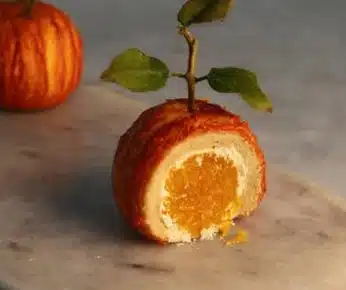
Health and Nutrition of Pastry Desserts
Calories and Sugar in Ornamental Pastries
An orange shaped pastry may look like a fruit, but don’t be fooled — it’s still a dessert. With layers of mousse, ganache, and decorative coatings, it can pack more sugar and fat than expected. That doesn’t mean you can’t enjoy it, but it’s smart to know what you’re eating.
Typical nutritional breakdown per serving:
- Calories: 250 to 350 per pastry
- Sugar: 20 to 25 grams
- Fat: 15 to 20 grams (mostly from cream and chocolate)
- Protein: Around 2 to 4 grams
- Carbohydrates: 25 to 35 grams
The values can differ based on the type of filling and coating used. A mousse-heavy pastry with minimal sponge or compote might be lighter than one with a ganache core and chocolate shell.
Though not a substitute for real fruit, the orange-shaped pastry offers indulgent satisfaction in a petite serving. Because of its richness, most people enjoy it slowly, which can help with mindful eating.
Lighter Filling Alternatives Using Fruit Purée Mousse
If you’re making your own orange shaped pastry at home, you have full control over the ingredients. This opens the door for healthier variations that don’t compromise flavor.
Here are some lighter swaps:
- Use fruit purées like orange, mango, or peach as the base instead of cream-heavy mousse
- Replace heavy cream with Greek yogurt for a high-protein option
- Swap white sugar for maple syrup, honey, or date paste
- Try agar agar instead of gelatin for a plant-based thickener
- Use low-fat chocolate or fruit glazes rather than butter-based coatings
These alternatives reduce fat and sugar while keeping the texture smooth and the citrus flavor front and center. You’ll still get that same wow-factor appearance, but in a more balanced way.
Balancing Indulgence with Fresh Fruit Servings
The orange shaped pastry can be part of a balanced diet when enjoyed in moderation and paired with nutrient-dense foods.
Try these smart pairing ideas:
- Serve with a side of sliced fresh oranges or citrus salad to add fiber
- Plate it with a dollop of Greek yogurt for protein and contrast
- Enjoy it after a light meal rich in vegetables to balance the richness
- Pair with sparkling water or herbal tea instead of sugary drinks
Visual appeal and indulgent flavors make this dessert exciting, but it’s your personal habits that decide how healthy it feels. By making conscious choices about how and when to enjoy it, you can indulge without overdoing it.
Whether you’re buying a bakery-made orange shaped pastry or crafting your own, a little nutrition awareness goes a long way.
Share Your Experience and Final Tips
Tried Making an Orange Shaped Pastry? Tell Us About It
Creating an orange shaped pastry is more than just baking. It’s an artistic project that brings your creativity to the kitchen. Whether your final result looks like it belongs in a Parisian pâtisserie or it’s a little off-center with a homemade charm, your effort matters.
If you’ve attempted this dessert, now’s the time to share your story. Maybe your mousse turned out perfectly smooth, or maybe your first glaze run didn’t go as planned. That’s part of the experience.
We’d love to know:
- What filling did you choose?
- Did you use a mold or shape it by hand?
- What challenges did you face?
- Would you make it again?
Sharing your wins (and even the fails) can help other home bakers take the leap and try something bold.
Final Tips for First-Time Bakers
If this is your first time tackling a fruit-shaped dessert like this, don’t worry. The learning curve is real, but the results are always rewarding.
Here are some last-minute tips to help you succeed:
- Plan ahead. This pastry involves freezing, layering, and decorating, so give yourself enough time.
- Use quality ingredients. Since flavors are simple, the taste of your cream, oranges, and chocolate will stand out.
- Work in stages. Prepare components separately and assemble when ready to reduce stress.
- Keep it chilled. A firm mousse and frozen insert will hold the shape better and make coating easier.
- Have fun with it. The best part about an orange shaped pastry is that it’s playful, so don’t stress over perfection.
Whether you’re baking it for a special event or just testing your skills, this citrus-inspired creation is guaranteed to turn heads.
You don’t have to be a pastry chef to craft something stunning. All you need is the right recipe, a few tools, and the courage to try.
Frequently Asked Questions About Orange Shaped Pastry
What are fruit-shaped pastries called?
Fruit-shaped pastries like the orange shaped pastry are often referred to as “entremets” in French pastry terms. These are multi-layered mousse desserts that are molded and decorated to mimic the shape, color, and texture of real fruits. The most realistic versions, like those made by Cédric Grolet, are crafted using silicone molds, velvet sprays, and natural fruit purées to achieve both visual and flavor accuracy.
What is an orange torte?
An orange torte is a traditional dessert that typically includes layers of sponge cake, citrus-flavored cream or ganache, and sometimes marmalade. While it shares citrus notes with the orange shaped pastry, a torte is generally presented in cake form and not sculpted to look like actual fruit. In contrast, an orange shaped pastry is an artistic, entremet-style dessert designed to replicate the look of a real orange.
What is an Italian peach-shaped pastry?
The Italian version of a fruit-shaped dessert is known as “Pesche Dolci” or peach cookies. These are not pastries in the mousse or entremet sense but are made from two cookie-like sponge halves sandwiched with chocolate or custard filling, then dipped in a peach liqueur syrup and coated in sugar. While they resemble a peach in appearance, they’re quite different from the mousse-based orange shaped pastry in terms of ingredients and structure.
What is a Czech pastry?
Czech pastries cover a wide range of regional baked goods, with kolaches being among the most popular. Kolaches are soft, yeasted pastries usually filled with fruit, cream cheese, or poppy seed mixtures. They do not attempt to resemble the fruit they are filled with, unlike the orange shaped pastry, which focuses on visual illusion as well as taste. While Czech pastries focus on classic fillings and dough, the orange-shaped dessert highlights modern aesthetics and intricate, layered composition.
What is an orange-shaped pastry, and why is it gaining popularity?
An orange shaped pastry is a mousse-based dessert crafted to look exactly like a real orange, often filled with citrus curd, marmalade, or ganache. It’s trending because of its highly realistic appearance, layered texture, and viral presence across TikTok and Instagram. The surprise element when slicing it open, paired with its vibrant colors and artisanal touch, makes it a social media favorite and a symbol of modern pastry creativity.
How can I make an orange shaped pastry at home?
To make an orange shaped pastry at home, you’ll need a silicone mold, citrus mousse or custard, a sponge base, and a coating like orange cocoa butter spray or glaze. Start by freezing the mousse in the mold, insert a filling like marmalade or sponge, and once fully frozen, spray or glaze the exterior to mimic the orange peel. With a bit of patience, anyone can recreate this dessert, even without professional tools.

